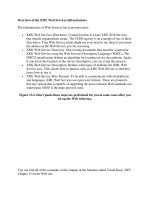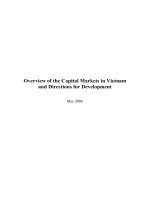01-Cable-Testing-Standards-Overview-of-the-IEEE-400-Bundle
Bạn đang xem bản rút gọn của tài liệu. Xem và tải ngay bản đầy đủ của tài liệu tại đây (2.28 MB, 40 trang )
CABLE TESTING
TESTING
CABLE
STANDARDS:
STANDARDS:
OOVVEERRVVIIEEWW OO FF TTHHEE
IEEE 400™ BUNDLE
1
Moderator
n Ron Spataro
AVO Training Institute Marketing Manager
2
Q&A
n Send us your
questions and
comments during
the presentation
3
Today’s Presenter: Alan Mark Franks
AVO Training Institute, Senior Cable Instructor and Curriculum Advisor
CABLE TESTING
STANDARDS: O V E R V I E W
IEEE 400™ BUNDLE
4
IEEE Cable Testing Standards
n Institute of Electrical and Electronic Engineers
5
•
IEEE-world’s largest technical professional organization
•
U. S. and global standards
•
Hundreds of standards including cable testing standards
•
Need for cable testing has existed the 1800’s
•
Guided IEEE 400 Series (Bundle) Standards
Need for Cable Testing Standards
n Cable Outage Research U.S.
• Studies National Electric Energy Testing Research and
Applications Center ( NEETRAC)
• Georgia Institute of Technology
• Indicate significant concern for U.S. cable installations
• Service-aged and new cable installations subject to same
workmanship issues
• 50% U.S. cable outages due to poor workmanship
6
U.S. Cable Failures
n Causes of Cable Failure
–
–
–
–
–
–
7
Inadequate cable prep
Poor assembly techniques
Not following instructions
Lack of training and experience
Inadequate cable installation
Environment not controlled
Outages by
equipment
type
Why Test?
•
•
•
•
•
•
•
8
Outages and repairs are costly
Negative effects on system reliability
Need for proactive maintenance
Find “bad actors” prior to failure
Best return on cable investment
Test after repairs
Test new installations
Where Do You Start
•
•
•
•
•
•
9
Identify status of existing cables
Prove new cable installations
Identify installation quality issues
Baselines for future cable testing
Basis for Condition Based Maintenance
Solutions for complex cable problems
IEEE 400 Series ( Bundle)
•
•
•
•
•
•
10
Five major standards
Guidelines for testing old and new cables
Current tests being utilized industry
“Living documents”
Provides methods, parameters, some evaluation criteria
Through examination specific to organizations needs
IEEE 400 Series ( Bundle)
§ IEEE 400 - 2012 (Omnibus)
• IEEE Guide for Field Testing and Evaluation of the Insulation of Shielded Power Cable
Systems Rated 5 kV and Above.
§ IEEE400.1 - 2007
• IEEE Guide for Field Testing of Laminated Dielectric, Shielded Power Cable Systems
Rated 5 kV and Above with High Direct Current Voltage.
§ IEEE 400.2 - 2013
• IEEE Guide for Field Testing of Shielded Power Cable Systems Using Very Low
Frequency (VLF) (Less Than 1 Hz).
§ IEEE 400.3 - 2006
• IEEE Guide for PARTIAL Discharge Testing of Shielded Power Cable Systems in a Field
Environment.
§ IEEE 400.4 - 2015
• IEEE Guide for Field Testing of Shielded Power Cable Systems Rated 5 kV and Above
with Damped Alternating Current (DAC) Voltage.
11
IEEE Cable Testing Standards
• Evolved with cable and testing technology
• Field Tests identified major categories
– Installation
– Acceptance
– Maintenance
• Further divided depending on user needs
– Withstand
– Diagnostic
12
IEEE 400 - 2012 (Omnibus)
IEEE Guide for Field Testing and Evaluation of the Insulation
of Shielded Power Cable Systems Rated 5 kV and Above.
•
•
•
•
•
13
The “omnibus” guide revised from 2001
Overview of available test methods
Description of test sources with discussion of tests
Does not address test results or parameters
Refers to “point” documents as definitive reference
IEEE 400 – 2012 (Omnibus)
IEEE Guide for Field Testing and Evaluation of the Insulation
of Shielded Power Cable Systems Rated 5 kV and Above.
•
•
•
•
14
Includes safety awareness
General discussions for field testing of cables
Field testing methods
Applicability testing methods & advantages/disadvantages
IEEE 400 – 2012 (Omnibus)
IEEE Guide for Field Testing and Evaluation of the Insulation
of Shielded Power Cable Systems Rated 5 kV and Above.
• Safety Awareness
– Regulations and standards observed
– Same factors as energized work
– Unique issues to testing present
– Work area protection and guarding
– Voltage verification required
– Grounding equipment required
– Voltage clearances maintained
15
IEEE 400 – 2012 (Omnibus)
IEEE Guide for Field Testing and Evaluation of the Insulation
of Shielded Power Cable Systems Rated 5 kV and Above.
• Protective grounding
• Rated and tested
• PPE required
Grounding
• Work area protection/guarding
• Minimum Approach Distances
• Insulation required
16
M.A.D.
15-0144
IEEE 400 - 2012 (Omnibus)
IEEE Guide for Field Testing and Evaluation of the Insulation
of Shielded Power Cable Systems Rated 5 kV and Above.
General discussions for field testing of cables
– Testing objectives.
– Cable systems to be tested.
– Operating conditions of cable and system components
– Suitable field tests.
– Documentation for analysis.
– Corrective actions on cable system.
17
IEEE 400 – 2012 (Omnibus)
IEEE Guide for Field Testing and Evaluation of the Insulation
of Shielded Power Cable Systems Rated 5 kV and Above.
Field Testing Methods (5)
1. Voltage Withstand
2. Dielectric Response
– Dissipation Factor (tan delta)
– Leakage current
– Recovery Voltage
– Polarization/Depolarization current
– Dielectric spectroscopy
18
IEEE 400 – 2012 (Omnibus)
IEEE Guide for Field Testing and Evaluation of the Insulation
of Shielded Power Cable Systems Rated 5 kV and Above.
Field Testing Methods (continued)
3. Partial discharge
– Electrical measurement
– Acoustical measurement
4. Time-domain reflectometry (TDR)
5. Thermal infrared imaging
19
IEEE 400 – 2012 (Omnibus)
IEEE Guide for Field Testing and Evaluation of the Insulation
of Shielded Power Cable Systems Rated 5 kV and Above.
Field Testing Methods
1. Voltage Withstand
• Simple (non-monitored ) withstand
– Ability to hold voltage is recorded
– Go/no-go test
• Monitored Withstand
– Other attributes monitored during test
– Dielectric response or PD
– Temporal stability
20
Very Low Frequency (VLF)
Withstand Test
IEEE 400 – 2012 (Omnibus)
IEEE Guide for Field Testing and Evaluation of the Insulation
of Shielded Power Cable Systems Rated 5 kV and Above.
Field Testing Methods
2. Dielectric Response (5 tests)
I. Dissipation factor (tan delta)
II. DC Leakage Current
III. Recovery Voltage
IV. Polarization/Depolarization Current
V. Spectroscopy
21
IEEE 400 - 2012 (Omnibus)
IEEE Guide for Field Testing and Evaluation of the Insulation
of Shielded Power Cable Systems Rated 5 kV and Above.
Dielectric Response (Continued)
– Provides overall insulation diagnosis
– Can be made at different frequencies or in different time domain
– Analyze effects but not locate defects
– Commonly measured termination to termination
– Values primarily influenced by condition, age etc.
– Results can be compared & used for trending
22
IEEE 400 - 2012 (Omnibus)
IEEE Guide for Field Testing and Evaluation of the Insulation
of Shielded Power Cable Systems Rated 5 kV and Above.
Dielectric Response (Continued)
I. Dissipation factor (Tan Delta)
– Loss factor increases as cable ages
– Tan delta measurement used as a diagnostic
– Ratio between loss current and charging current
– Loss current increases as cable ages increasing tan delta angle
– Absolute tan delta, tip-up and stability values are derived
23
IEEE 400 – 2012 (Omnibus)
IEEE Guide for Field Testing and Evaluation of the Insulation
of Shielded Power Cable Systems Rated 5 kV and Above.
Dielectric Response (Continued)
II. DC leakage current
– DC voltage lower than withstand applied
– Measures current flowing through insulation
– HVDC not recommended for aged extruded
cables
– Measurements taken at steady state
voltage
– Performed as a step test
– Cables discharged 4 times test duration
after test
24
IEEE 400 – 2012 (Omnibus)
IEEE Guide for Field Testing and Evaluation of the Insulation
of Shielded Power Cable Systems Rated 5 kV and Above.
Dielectric Response (Continued)
III. Voltage recovery
– Charged with DC voltage for given time
– Discharged with ground resistor
– Open circuit voltage recorded versus time
– Can indicate moisture in PILC cables
– Uses to indicate water tree degradation
25









